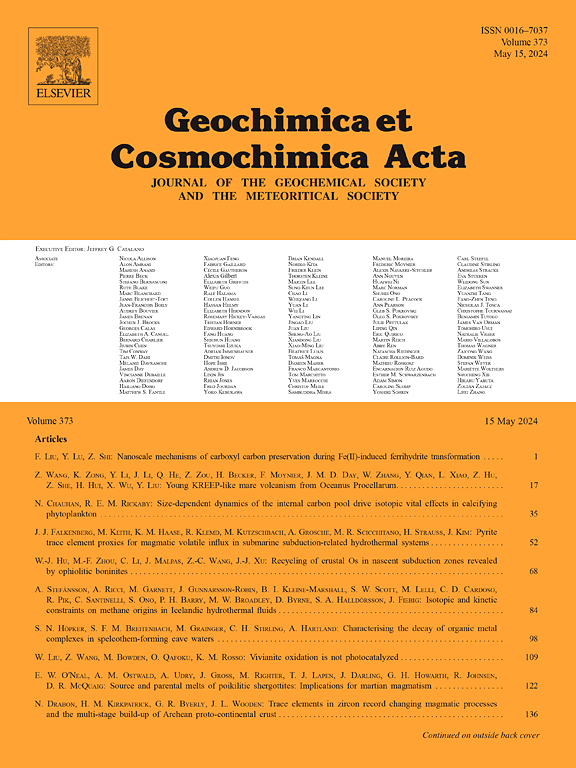Monazite saturation in carbonatite melts at crustal and upper mantle conditions
IF 4.5
1区 地球科学
Q1 GEOCHEMISTRY & GEOPHYSICS
引用次数: 0
Abstract
Monazite (XPO4 where X = light rare earth element) is one of the most important ore minerals for rare earth elements (REE) mined from carbonatites. This study explores the influence of pressure, temperature and melt composition on the solubility of monazite in carbonate melt using piston cylinder experiments. We aim to understand how such a highly soluble phosphate mineral may sometimes crystallise from carbonatite magma and form economic deposits of REE. Our findings reveal that the solubility of monazite in a sodic-dolomitic carbonate melt is high over the entire pressure (1.0–2.0 GPa), temperature (1000-1450˚C), and compositional space (Na2O-CaO-MgO-SiO2-F) of our study. It increases from ∼ 26 to ∼ 61 wt% CePO4 equivalent over the temperature range of 1000–1450 °C at 2 GPa. However, the solubility product constant (lnKsp) decreases by approximately ∼ 23 % and 21 % equivalent with increasing melt SiO2 (from 0 to ∼ 18 wt% melt SiO2) at 1275 °C and fluoride (from 0 to ∼ 5 wt% melt F-) concentrations at 1100 °C respectively. Variations in melt Ca# (atomic Ca/(Mg + Ca) = 0.2–1.0) and pressure (1.0–2.0 GPa) have negligible impacts on monazite solubility. We use the experimental data to formulate an empirical model relating the solubility product constant (Ksp) of monazite in carbonate melt to temperature and melt compositional parameters:
where [] represents the mole fractions of oxides in the melt of the rare earth elements, phosphorus and silicon, and fluoride, T is in Kelvin, and the parentheses indicate standard errors. represents the summation of the melt REE concentrations for those REE which are compatible in the experimentally synthesized monazite (La-Sm and Gd). These experimental results suggest that the formation of monazite requires relatively high concentrations of P2O5 and Ce2O3 under crustal pressure and temperature conditions, making it challenging to crystallise directly from carbonatite melts. However, monazite may instead form through reactions involving evolved carbonatite melts, potentially interacting with siliceous wall rocks or replacing pre-existing phosphates like apatite, as has been observed in natural carbonatites.
求助全文
约1分钟内获得全文
求助全文
来源期刊

Geochimica et Cosmochimica Acta
地学-地球化学与地球物理
CiteScore
9.60
自引率
14.00%
发文量
437
审稿时长
6 months
期刊介绍:
Geochimica et Cosmochimica Acta publishes research papers in a wide range of subjects in terrestrial geochemistry, meteoritics, and planetary geochemistry. The scope of the journal includes:
1). Physical chemistry of gases, aqueous solutions, glasses, and crystalline solids
2). Igneous and metamorphic petrology
3). Chemical processes in the atmosphere, hydrosphere, biosphere, and lithosphere of the Earth
4). Organic geochemistry
5). Isotope geochemistry
6). Meteoritics and meteorite impacts
7). Lunar science; and
8). Planetary geochemistry.
 求助内容:
求助内容: 应助结果提醒方式:
应助结果提醒方式:


